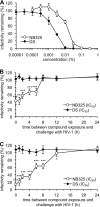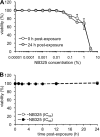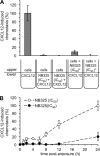Persistent interactions between biguanide-based compound NB325 and CXCR4 result in prolonged inhibition of human immunodeficiency virus type 1 infection
- PMID: 20231400
- PMCID: PMC2863618
- DOI: 10.1128/AAC.00934-09
Persistent interactions between biguanide-based compound NB325 and CXCR4 result in prolonged inhibition of human immunodeficiency virus type 1 infection
Abstract
We previously demonstrated that the biguanide-based compound NB325 inhibits human immunodeficiency virus type 1 (HIV-1) infection by interacting with the CXCR4 viral coreceptor. This interaction also appeared to be persistent, since HIV-1 infection was inhibited even when the virus was introduced subsequent to the removal of NB325 from the cell culture medium. The present studies were conducted to determine the extent and mechanism of this prolonged antiviral activity. Persistent inhibition of HIV-1 infection by NB325 was concentration dependent and was apparent up to 8 h after removal of the compound. Flow cytometric analyses of stimulated CD4(+) T lymphocytes exposed to NB325 demonstrated concentration-dependent reductions in CXCR4 extracellular loop 2 epitope recognition that were maintained up to 24 h after removal of the compound. CXCL12-induced chemotaxis was also persistently inhibited following pre-exposure to NB325. These results demonstrate that persistent inhibition of X4 HIV-1 infection by NB325 involves extended perturbation of the viral coreceptor CXCR4.
Figures






References
-
- Balzarini, J., W. G. Brouwer, D. C. Dao, E. M. Osika, and E. De Clercq. 1996. Identification of novel thiocarboxanilide derivatives that suppress a variety of drug-resistant mutant human immunodeficiency virus type 1 strains at a potency similar to that for wild-type virus. Antimicrob. Agents Chemother. 40:1454-1466. - PMC - PubMed
-
- Borkow, G., J. Barnard, T. M. Nguyen, A. Belmonte, M. A. Wainberg, and M. A. Parniak. 1997. Chemical barriers to human immunodeficiency virus type 1 (HIV-1) infection: retrovirucidal activity of UC781, a thiocarboxanilide nonnucleoside inhibitor of HIV-1 reverse transcriptase. J. Virol. 71:3023-3030. - PMC - PubMed
-
- Broxton, P., P. M. Woodcock, and P. Gilbert. 1984. Binding of some polyhexamethylene biguanides to the cell envelope of Escherichia coli ATCC 8739. Microbios 41:15-22. - PubMed
-
- Broxton, P., P. M. Woodcock, and P. Gilbert. 1984. Injury and recovery of Escherichia coli ATCC 8739 from treatment with some polyhexamethylene biguanides. Microbios 40:187-193. - PubMed
-
- Broxton, P., P. M. Woodcock, and P. Gilbert. 1983. A study of the antibacterial activity of some polyhexamethylene biguanides towards Escherichia coli ATCC 8739. J. Appl. Bacteriol. 54:345-353. - PubMed
Publication types
MeSH terms
Substances
Grants and funding
LinkOut - more resources
Full Text Sources
Medical
Research Materials

